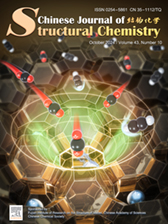
Cover Picture
Electrostatically driven kinetic Inverse CO2/C2H2 separation in LTA-type zeolites
Yongheng Ren, Yang Chen, Hongwei Chen, Lu Zhang, Jiangfeng Yang, Qi Shi, Lin-Bing Sun, Jinping Li, Libo Li*
Submit a Manuscript
Electrostatically driven kinetic Inverse CO2/C2H2 separation in LTA-type zeolites
Yongheng Ren, Yang Chen, Hongwei Chen, Lu Zhang, Jiangfeng Yang, Qi Shi, Lin-Bing Sun, Jinping Li, Libo Li*
Submit a Manuscript
Temperature- and pressure-responsive photoluminescence in a 1D hybrid lead halide
Huan Hu, Ying Zhang, Shi-Shuang Huang, Zhi-Gang Li, Yungui Liu, Rui Feng*, Wei Li*
Chin. J. Struct. Chem., 2024, 43: 100395. DOI: 10.1016/j.cjsc.2024.100395
October 15, 2024
Low-dimensional hybrid lead halides; Stimuli-responsive; Self-trapped excitons; Electron-phonon coupling; Emission enhancement
ABSTRACT
Low-dimensional hybrid lead halides with responsive emissions have attracted considerable attention due to their potential applications in sensing. Herein, a new one-dimensional hybrid lead bromide CyPbBr3 (Cy = cytosine cation) was synthesized to explore its emission evolution in response to temperature and pressure. The compound possesses an edge-sharing 1D double-chain structure and emits warm white light across nearly the entire visible spectrum upon ultraviolet excitation. This emission arises from the self-trapped excitons and its broadband feature is attributed to the strong electron-phonon coupling as revealed by the variable-temperature photoluminescence experiments. Moreover, a 4.5-fold pressure-induced emission enhancement was observed at 2.7 GPa which is caused by the pressure suppressed non-radiative energy loss. Furthermore, in-situ powder X-ray diffraction and Raman experiments reveal the maxima of the emission enhancement is associated with a phase transition at the same pressure. Our work demonstrates that low-dimensional metal halides are a promising class of stimuli-responsive materials which could have potential applications in temperature and pressure sensing.







